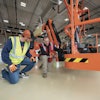
The challenge:
Constructing a three-story office building using tilt-up concrete construction and banded windows instead of the typical punched openings
The players:
Metropolitan Contracting Company LLC
Beicker Martinez Engineering
White Cap
The process:
As a winner of the Excellence in Achievement award for the 2012 Tilt-Up Concrete Association’s 2012 Annual Achievement Awards, this three-story, 45,256-square-foot San Antonio office building was designed with tilt-up construction with the stipulation that it would have "ribbon" or banded windows (continuous, uninterrupted horizontal bands of glass) in lieu of the traditional punched openings that characterize a tilt-up building.
Ribbon windows created using the technique of recessing the concrete leg and allowing the glass to pass in front of the concrete thereby creating a continuous horizontal glass band on the exterior were discussed and rejected. The project required true see-through glass, inside and out. Because no existing tilt-up technology would solve this challenge, the contractor collaborated with a structural engineering firm, Beicker Martinez Engineering, to develop a design to eliminate the traditional concrete legs and replace them with steel columns embedded in multiple concrete spandrel panels.
As opposed to building a steel structure and then hoisting and hanging concrete spandrels on it, the work would be performed on the ground. The composite wall panels would then be erected just like conventional tilt-up allowing true, continuous horizontal glass. The newly christened ClearView Composite Wall System (patent-pending) was then presented to the project team and received enthusiastic approval.
After extensive preplanning to assure that the engineering of the panels for embeds, layout and erection sequence were firm, the steel arrived, the forms were built, the concrete poured, and the columns were embedded in smooth sequence. The balance of the building construction followed in a typical manner, resulting in a very attractive design that highlights the versatility of the new system with many different glass treatments, juxtaposed panels in multiple planes and a generally bold, undisguised, aesthetic use of the concrete elements. The new tilt-up panels are more easily formed, 30 percent lighter than and about the same cost of traditional tilt-up, yet provide greater design creativity, including true banded glass.

















